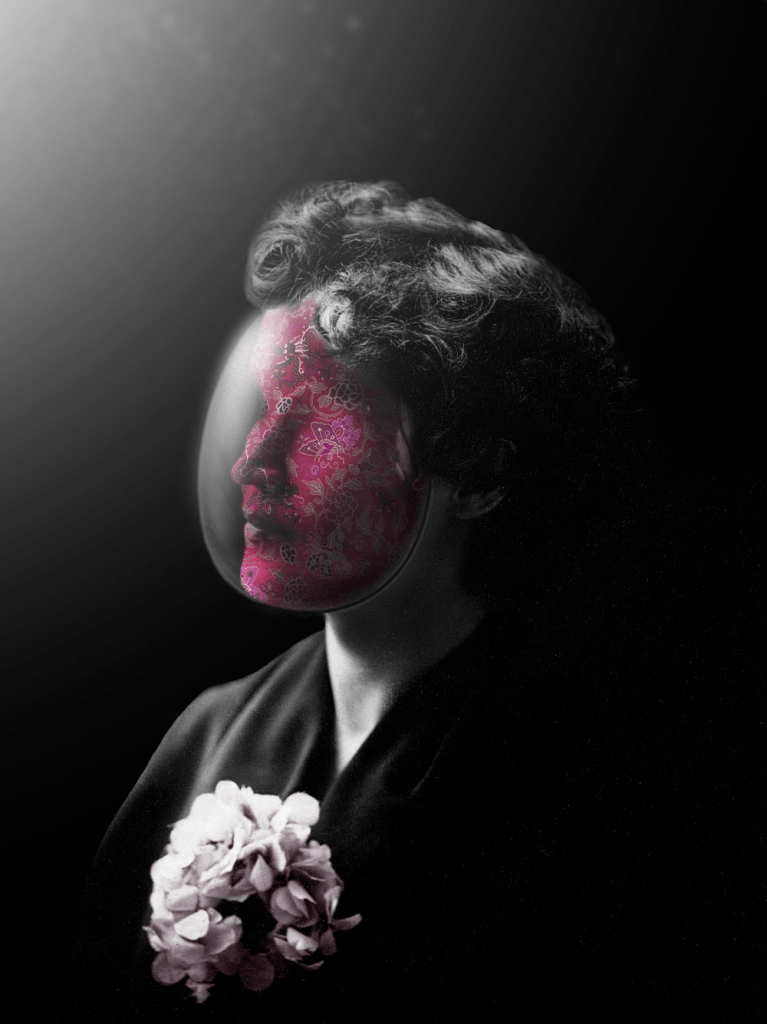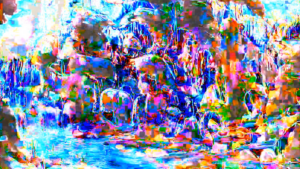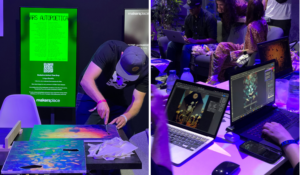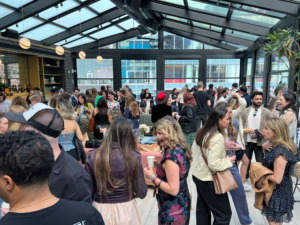The Triple Threat: Curation, Creation and Artist Management
Brady Walker: Animus, welcome. For people who aren’t familiar with you and your work in this space, could you briefly introduce yourself?
Animus: I’ve been a collector of physical art for over 35 years. I got into trading crypto a bit in 2017 and started collecting NFTs in early 2021. About nine months ago, I was invited to curate some outdoor exhibitions for an initiative called Artcrush. Initially, they asked me to select a few pieces for their curator who works for Sotheby’s Metaverse. He and the founder liked my selections, so they asked me to do more — first six, then another 15. Then, they asked me if I’d like to co-curate and I selected another 125 artworks. I’ve been in business for many years, with partners in The Netherlands and London. I called them up and told them that I was taking a sabbatical because I was going to be busy for a few months. And that was nine months ago.
Brady Walker: Are you still on sabbatical?
Animus: I am. I think it’s going to be permanent. I’ve been a good partner and pulled my weight for many years. They’re willing to hold the fort and I’ll still have my share. They’re great partners.
Brady Walker: What is it about curation that’s so exciting to you that you’re willing to step away from an established business?
Animus: I think it’s more the creation than the curation, although they’re both important to me. Another pivotal event that occured shortly after I started my sabbatical was being introduced by Laurence Fuller to Randy Levy, Val Kilmer’s partner in web3. They wished to thank me for featuring one of Val and Laurence’’s Poetics works in an outdoor exhibition.
Randy asked me what I wished to do next. I told him I wanted to create. He suggested that Val and I produce a work together. So I brought in a few artists, some of whom are in my collection, like Limbo Mask and Valérie Biet. We collaborated on a piece also with Sasha Barbolin, Von Doyle, Laurence Fuller and Kamp Kilmer.
Then, the same group working with Val began creating NFTs with Sarah Ferguson, The Duchess of York. They asked me if I’d like to contribute, and I was already representing Norwegian Master oil painter Arne Spangereid. We came up with a brilliant collaboration with Her Grace. It’s been very gratifying.
Creation, curation, and managing artists — I accomplished all three in our collaboration with the Duchess of York. In a period of three or four months, we took Arne Spangereid from $50 to almost $6000 for a one-of-one.

A Lifelong Passion: From Collecting to Curating
Brady Walker: By creation, are you referring to commissioned work where you’re arranging collaborations, or are you creating art yourself?
Animus: I’m definitely talking about collaboration. Quite a few artists trust my aesthetic sensibilities and market judgment enough to ask for my creative input, and sometimes I offer it unsolicited. Things like conceptualizing a project, choosing the artists, and trying to select artists whom I believe will create works that align with and creatively advance a theme — this brings me a great deal of satisfaction.
Brady Walker: In your experience, what distinguishes good curation from bad curation?
Animus: I believe good taste is the main factor, and also dedication. I’ve been working 16-18-hour days without any significant remuneration for the last nine months because I take it seriously.
Brady Walker: Where does this passion for art come from that leads you to such commitment?
Animus: It stems from my upbringing. My parents collected art and antiques, and my mother took me to art auctions when I was around eight or nine years old. By the age of 10, I had my own paddle to bid on items. We had a Picasso and some nice antiques in our collection, and I appreciated them. I had to go into business at 19, and the combination of my early exposure to art and the events of the last nine months ignited something in me. It feels like this is what I was meant to be doing.
Brady Walker: Could you tell me a bit about your traditional art collection?
Animus: I started by collecting objet d’art, items like an Edwardian glove box that I bought at an art auction when I was 10. It’s beautifully inlaid. I inherited my parents’ Picasso drawing, which is pretty cool. My collection is wide-ranging, with no specific focus on a genre or period. It includes everything from tiny works to rather large ones, antiques to paintings.
Brady Walker: Even within digital art, you’re collecting or working with art from different eras. Is that one of the joys of this space for you?
Animus: Definitely, it’s one of the things I love about this space.

Personalization and Connection
Brady Walker: How important is it for you to get to know the artist behind the art? It seems like you maintain very active relationships with a lot of artists.
Animus: That’s another aspect that genuinely motivates me. When I used to watch sports as a kid, I was always more intrigued by the backstories, the personalization of the athlete, and their stories of struggle and triumph. I tend to personalize things in general, so being emotionally involved and having intimate relationships with the artists definitely motivates me. There are more than 100 artists I deeply care for.
Brady Walker: I think this is an important note for any artists listening to or reading this. One of my frustrations in writing about art in this space is that artists often take their work so seriously that they deem their literal stories to be less important. But these stories can provide an anchoring narrative that ties the work together. Outside of the narrative, is there something about your tastes that makes you look at something and instantly like it? Are there “of course, I would like that” kind of moments? If so, what are those things?
Animus: I really connect with Arne Spangereid’s work. That’s why I manage him. I have the same kind of connection and collaborative management relationship with Richard Nadler. On a personal level, they are very professional and wonderful to deal with. Each of them infuses a bit of sly humor into their art. I often respond to subtle humor, subtle irony, and wild juxtapositions. These are components which resonate with me.
Another artist whom I adore is the Russian photographer, Olga Shpak. Her work often features these wild juxtapositions presented in a very serious, sometimes Vermeer-like manner. I appreciate that. I also appreciate broader satire, like Alotta Money. But overall, sly humor and subtle irony are two elements that I strongly respond to.
Brady Walker: As an avid collector, curator, and artist manager, do you notice common mistakes among artists who work as their own manager, marketer, or self-promoter? How can they improve?
Animus: It’s typically easier to promote someone else rather than one’s self. Having someone trustworthy critiquing your curation decisions – what to display, where, and when – can greatly help. They could advise on what would suit the sensibilities, aesthetics, or zeitgeist of a particular exhibition, city, or country.
A manager should also give a strong opinion on pricing and supply-demand dynamics. These things are quite difficult to handle on your own — for instance, I started my journey with Arne at the beginning of his web3 adventure.
When Richard Nadler approached me, he was already an extremely successful, established artist. He said that he wished my involvement because he was already working 16 hours a day and couldn’t manage to work more than that. Many artists realize that they can’t produce and be active on Twitter 18 hours a day like Laurence Fuller. Most aren’t equipped for that.
Brady Walker: So, you mentioned self-curation, pricing, and supply and demand as key areas artists should focus on if they want to manage themselves. Plus, of course, self-promotion, like being active on Twitter.
Animus: Yes, and promoting other artists is crucial if you’re going to self-promote.
Brady Walker: Absolutely. The best self-promoters often draw attention to themselves by talking about the artists they genuinely appreciate. Since you’ve curated for a lot of real-life events, what are your thoughts on displaying digital art? How is it best experienced, and do you have a specific setup at home for your digital art?
Animus: Two prominent methods for displaying digital art are huge projections in urban settings, which can be quite dramatic, and immersive environments, which are becoming more prevalent. Both are esential. Bringing art to the streets is significant, as is displaying art in a perfect space with perfect sound for a more limited audience.
As for my home and office setups, I use relatively large screens, like 80-inch ones, to display my artwork.
Brady Walker: Can you tell me about the Flannels Exhibition?
Animus: In the basement of the Flannels flagship store on Oxford Street in London, they have an amazing immersive exhibition space, complete with state-of-the-art sound when appropriate. It’s a truly powerful experience.
For instance, there will be an incredible immersive theater at NFT Lisbon where Leo Crane from Sotheby’s Institute and I are teasing his gorgeously animated art film Tamagata through Iham Gallery Paris. During the conference, we’ll be releasing the first in a limited series of NFTs on MakersPlace in conjunction with the film. Laurence Fuller, will be showcasing his work there.
Bridging Worlds: Integrating Traditional Art Collectors into the web3 Space
Brady Walker: I have a question that came from one of your artists, Arne Spangereid, I believe. You’ve worked with some of the most recognized painters in the web3 space. How do you see their situation?
Animus: Situation? I don’t see any particular issue. Some perceive a division between oil painters and those who create in a digitally native environment, but I don’t see any division or problem. What’s your take?
Brady Walker: From my experience, it seems there are collectors who are uninterested in the physical component of a painting that has been digitized and sold as an NFT. That said, I also see it as a great way for painters to expose their work to people outside of the traditional art world avenues. MakersPlace has its unlockable features that make it more accessible for painters and collectors to engage. While I understand why some might be disinterested in the physical component, I also see a huge advantage there.
Animus: I recently had a conversation with Craig Palmer, your CEO, at a dinner he hosted during NFT Paris. I emphasized the importance of bringing traditional art collectors into the web3 space. Encouraging physical collectors to buy an oil painting or a museum-quality giclée print on MakersPlace, with the bonus of a free digital version, is a paradigm shifting opportunity. I expressed my view to Craig that MakersPlace can position itself as The bridge between the traditional and the web3 art worlds.
Brady Walker: I think that’s a great reframe — that the NFT is essentially a receipt for the painting that you bought. A very good-looking receipt that you can display.
Animus: Beautifully expressed. Exactly.
Brady Walker: I have another question from Laurence Fuller. How did the Poetics exhibition change the way you saw web3 art? He added #PoeticsNFT.
Animus: It’s a great question. The Poetics series was indeed momentous for me as a collector. I deeply connected with Laurence’s dulcet tones speaking over these works. One of them was a piece by Val Kilmer.
As we all know, Val doesn’t have the use of his voice at the moment, so he wrote a poem. goldcat painted a representation of Val, and Laurence read Val’s poem. That piece deeply resonated with me on a profound aesthetic and emotional level. Moreover, it changed the course of my life, practically speaking. I exhibited this piece in Ghent, Belgium, nine months ago, which led to a call from Val’s partner asking me what I wished to do next.

Brady Walker: Did you play any part in bringing those pieces together? With Val, Laurence, and goldcat?
Animus: Tania Rivilis also did a stunning representation of Val, with Laurence ‘s voice. I didn’t have anything to do with the creation of those collaborations, but it led to my subsequent collaboration with Val. Within a month of that event, I was creating something with Valérie Biet, Limbo Mask, Sasha Barbolin, Von Doyle and Kamp Kilmer, alongside Laurence.
Brady Walker: You come into this space with a lot of energy and determination. Where did this work ethic come from? You mentioned working 16-18-hour days for no remuneration, just for the simple pleasure.
Animus: The simple pleasure indeed. The current market conditions lend themselves perfectly to building for the future. People are leaving or waiting for another bull run. Those truly committed to this space now will be well-positioned in the future.
As for my work ethic, I’ve been working since I was 10 years old, perhaps in reaction to the fact that neither of my parents were particularly driven. But they were passionate about art. My father was a Grammy Award-winning jazz musician, a true creative. My mother was a serious collector. So, I received that drive or passion for art from them. My specific work ethic, though, might be a reaction to their lack of drive.

Brady Walker: Being a Grammy-winning jazz musician is no small feat. It takes a lot of grit and determination to become a competent jazz musician.
Animus: It was for a 22-second solo on a record from the Jazz Era, and he received it posthumously. He was a great artist.
From Collector to Collaborator
Brady Walker: Can you tell me about some of your favorite pieces in your collection? Perhaps the ones that come to mind most readily, so no one feels excluded?
Animus: The 12 pieces we’re featuring in the collection exhibited by MakersPlace are among my absolute favorites.
“Bitcoin vs The Establishment” is an iconic work. Limbo Mask is an amazing artist, as are Valérie Biet and Hackatao in their collaboration, “Get Lost in the Remix.” That piece has significant symbolic value for me. It was the first artwork that astonished me to the extent that I stayed up all night for an auction that started at 12:30 AM my time. I didn’t mind paying $10,000 for it. That was my first significant purchase.
There were larger purchases later and significant ones that I just missed. For instance, I bid $65,000 on a piece by David Cronenberg’s daughter but was outbid. I tried to counter the bid but was too late. The blockchain tells this sad tale. Despite that disappointment, I knew that it was a piece of digital art that I connected with so deeply, I didn’t care about the cost.

Collecting Epiphanies
Brady Walker: Can you tell me about one of your more recent acquisitions?
Animus: Before I move to that, I want to mention another work I felt compelled to have. “Epiphany” by Reinhardt Schmid, another piece from the collection, is something I absolutely adore. Reinhard is a real OG in this space. He’s asked me to help manage him as well. He was one of the first artists to buy and mint on MakersPlace. His five-year anniversary is coming up on August 27th. Negotiating with him was quite challenging, but it was a work that I had to have. He just astonished me by giving me the physical piece.
This piece is the second work displayed in the Collection. He told me a bit about it, mentioning that I might be surprised by its tiny size and how it had been lovingly displayed in Paris. He sent it to me a week ago. Although it’s one of my oldest NFT acquisitions, it’s one of my most recent physical ones.
You asked about my most recent acquisition? “Waiting for the Sun” by Arne Spangereid, which somewhat echoes “Eyes Wide Shut,” was bought in the last couple of months. [In a Twitter Spaces] Jarid Scott announced the few remaining minutes left to bid, and I wanted it for myself. I wasn’t sure if anyone else would outbid me, but as a collector, I wanted to have it.

Brady Walker: I remember that moment when Jarid announced that it went to you.
Animus: I wasn’t sure how that looked, but I was concerned that beloved collector and hero in our space BlockMuse might jump in. He paid a princely sum for another of Arne’s works.
Brady Walker: It’s interesting to hear about the friendly rivalries between collectors.
Animus: Indeed, I really admire BlockMuse and everything he stands for. When people refer to me as an artist champion and community builder, I think of him.
Brady Walker: As we approach the end of our interview, Laurence has one last question. It’s a broad one: what is the importance of beauty in the modern world?
Animus: Beauty is everything to me. I firmly believe in the old saying, “beauty is its own reward.” I’m extremely sensitive to beauty. While I might come across as tough, beauty has a profound emotional effect on me. The power of beauty can sometimes be so overwhelming that it almost blinds me. Perhaps that’s a broad answer, or perhaps it’s quite specific.
For updates on all of our upcoming editorial features, subscribe to our newsletter below.
- SEO Powered Content & PR Distribution. Get Amplified Today.
- PlatoAiStream. Web3 Data Intelligence. Knowledge Amplified. Access Here.
- Minting the Future w Adryenn Ashley. Access Here.
- Buy and Sell Shares in PRE-IPO Companies with PREIPO®. Access Here.
- Source: https://rare.makersplace.com/2023/05/30/interview-with-curator-collector-and-artist-manager-animusnft/?utm_source=rss&utm_medium=rss&utm_campaign=interview-with-curator-collector-and-artist-manager-animusnft
- :has
- :is
- :where
- $UP
- 000
- 1
- 10
- 100
- 12
- 15%
- 2017
- 2021
- 27th
- 30
- 9
- a
- About
- about IT
- Absolute
- absolutely
- accessible
- accomplished
- acquisition
- acquisitions
- across
- active
- added
- advance
- ADvantage
- Adventure
- advise
- After
- age
- ago
- align
- All
- alongside
- already
- also
- Although
- always
- am
- amazing
- among
- an
- and
- Anniversary
- announced
- Another
- answer
- any
- anyone
- anything
- appreciate
- approach
- appropriate
- ARE
- areas
- around
- Art
- Art Collectors
- artist
- Artists
- artwork
- artworks
- AS
- aspect
- At
- Athlete
- attention
- Auction
- Auctions
- audience
- AUGUST
- award-winning
- away
- Bad
- BE
- beautifully
- Beauty
- because
- become
- becoming
- been
- before
- began
- Beginning
- behind
- being
- Belgium
- believe
- beloved
- below
- BEST
- between
- bid
- Bit
- blockchain
- Bonus
- both
- bought
- Box
- BRIDGE
- briefly
- brilliant
- Bringing
- Brings
- broad
- broader
- brought
- builder
- Building
- bull
- Bull Run
- business
- busy
- but
- buy
- by
- call
- called
- came
- CAN
- care
- ceo
- challenging
- champion
- change
- changed
- choosing
- City
- collaborated
- collaboration
- collaborations
- collaborative
- Collecting
- collection
- collector
- collectors
- combination
- come
- coming
- commitment
- committed
- Common
- community
- compelled
- competent
- complete
- component
- components
- concerned
- conditions
- Conference
- Connect
- connected
- connection
- contribute
- Conversation
- Cool
- Cost
- could
- Counter
- country
- Couple
- course
- Craig
- create
- Creating
- creation
- Creative
- Creatively
- crucial
- crypto
- curated
- curation
- Current
- David
- day
- Days
- deal
- decisions
- dedication
- definitely
- Demand
- Despite
- determination
- DID
- different
- difficult
- digital
- Digital Art
- digitally
- digitized
- Dinner
- disappointment
- Display
- displaying
- Division
- do
- does
- Doesn’t
- doing
- Dont
- dramatic
- draw
- drawing
- drive
- driven
- during
- dynamics
- each
- Early
- easier
- Editorial
- effect
- elements
- else
- emphasized
- encouraging
- end
- energy
- engage
- Enigma
- enough
- Environment
- environments
- equipped
- Era
- essentially
- established
- establishment
- Ethic
- Even
- Event
- events
- everything
- exactly
- exciting
- excluded
- exhibition
- Exhibition Space
- Exhibitions
- experience
- experienced
- Exposure
- expressed
- extremely
- fact
- factor
- familiar
- Favorite
- Favorites
- feat
- Features
- Featuring
- few
- Film
- firmly
- First
- flagship
- Focus
- For
- Fort
- founder
- four
- Free
- friendly
- from
- Frustrations
- Fuller
- future
- Gala
- Gallery
- General
- get
- Give
- Giving
- Go
- going
- good
- great
- greatly
- Group
- had
- handle
- Have
- having
- he
- hear
- help
- her
- Hero
- him
- his
- hold
- Home
- hosted
- HOURS
- How
- HTTPS
- huge
- Humor
- i
- I’LL
- iconic
- if
- immersive
- importance
- important
- improve
- in
- includes
- incredible
- initially
- Initiative
- input
- instance
- instantly
- Institute
- Integrating
- interesting
- Interview
- intimate
- into
- introduce
- introduced
- invited
- involved
- involvement
- irony
- issue
- IT
- items
- ITS
- itself
- journey
- joys
- jump
- just
- Key
- Key Areas
- Kid
- Kind
- Know
- Lack
- large
- larger
- Last
- Late
- later
- Leads
- leaving
- Led
- left
- LEND
- LEO
- less
- Level
- Life
- like
- Limited
- Lisbon
- Listening
- London
- Look
- looked
- lost
- Lot
- love
- magazine
- mailchimp
- Main
- maintain
- make
- MAKES
- manage
- management
- manager
- managing
- manner
- many
- Market
- market conditions
- mask
- master
- max-width
- meant
- mentioned
- Metaverse
- methods
- might
- mind
- mint
- minutes
- missed
- mistakes
- Modern
- moment
- Moments
- money
- Month
- months
- more
- Moreover
- most
- mother
- move
- Musician
- my
- NARRATIVE
- native
- Neither
- Netherlands
- Newsletter
- next
- NFT
- NFTs
- nice
- night
- no
- Norwegian
- Notice..
- now
- of
- offer
- Office
- often
- Oil
- Old
- oldest
- on
- ONE
- ones
- Opinion
- Opportunity
- or
- Other
- our
- Outdoor
- outside
- over
- overall
- own
- Oxford
- paid
- painting
- paintings
- paradigm
- parents
- paris
- part
- particular
- particularly
- partner
- partners
- passion
- passionate
- paying
- People
- perfect
- perhaps
- period
- permanent
- personal
- personalization
- personalize
- photographer
- physical
- Picasso
- piece
- pieces
- pivotal
- plato
- Plato AiStream
- Plato Data Intelligence
- PlatoAiCast
- PlatoData
- Play
- pleasure
- plugin
- plus
- position
- power
- powerful
- practically
- presented
- pretty
- prevalent
- pricing
- Problem
- produce
- professional
- profound
- project
- projections
- prominent
- promote
- promoting
- provide
- purchase
- purchases
- question
- rather
- reaction
- Read
- Reading
- real
- realize
- really
- received
- recent
- recently
- recognized
- record
- relationship
- Relationships
- relatively
- releasing
- remaining
- remember
- Remix
- remuneration
- representation
- representing
- Resonate
- Respond
- Reward
- Richard
- Run
- russian
- Said
- same
- satire
- satisfaction
- saying
- scott
- screens
- Second
- see
- seems
- selected
- SELF
- sensibilities
- sensitive
- sent
- Series
- serious
- settings
- setup
- Share
- SHIFTING
- Shortly
- should
- showcasing
- significant
- Simple
- since
- situation
- SIX
- Size
- Sly
- small
- So
- sold
- some
- Someone
- something
- somewhat
- son
- Sound
- Space
- spaces
- speaking
- specific
- Sports
- stands
- started
- state-of-the-art
- stayed
- stems
- Step
- Still
- store
- Stories
- street
- strong
- strongly
- Struggle
- Stunning
- subscribe
- subsequent
- successful
- such
- Suit
- Sun
- supply
- Supply and Demand
- surprised
- Take
- takes
- taking
- tale
- talking
- taste
- tell
- tells
- than
- thank
- that
- The
- The Future
- the Netherlands
- Theater
- their
- Them
- theme
- themselves
- then
- There.
- These
- they
- things
- think
- this
- those
- though?
- threat
- three
- Through
- Ties
- time
- to
- together
- too
- took
- Trading
- trading crypto
- traditional
- tried
- Triple
- true
- truly
- Trust
- trustworthy
- Twitter Spaces
- two
- typically
- understand
- unsolicited
- upcoming
- Updates
- urban
- use
- used
- VAL
- value
- Venus
- version
- very
- View
- Voice
- von
- vs
- Waiting
- want
- wanted
- was
- Watch
- Way..
- we
- Web3
- Web3 space
- week
- weight
- welcome
- WELL
- went
- were
- What
- What is
- when
- which
- while
- WHO
- why
- wide
- Wild
- will
- willing
- with
- within
- without
- wonderful
- WordPress
- WordPress plugin
- Work
- work together
- worked
- working
- works
- world
- world’s
- would
- writing
- X
- years
- yes
- york
- you
- Your
- yourself












